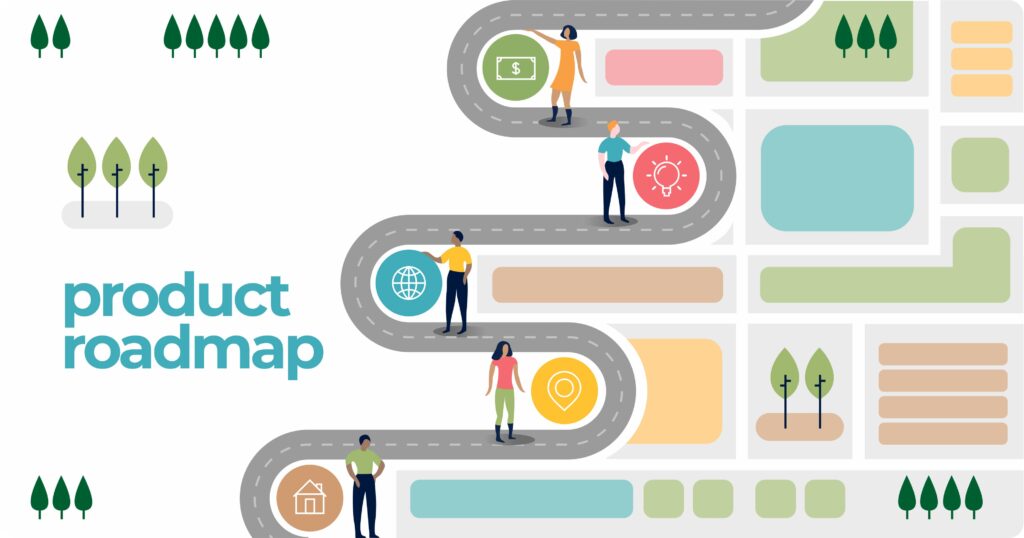Creating a product roadmap is a vital part of every product manager. Roadmaps are required to coordinate the product development process. They ensure that ongoing daily tasks align with and contribute to your high-level business strategy. So in this article, we will explain how to create a successful product roadmap.
What is a product roadmap?
A product roadmap is an essential blueprint for your product. This helps you plan your product and its growth while enabling your team to drive that growth. It is what allows product organisation and Product Managers to know and report where you are, where you are going, and what steps to take along the way. In other words, the product roadmap is the main output of the studies put forward in product management. As a result of all analysis, testing, user experience studies and the data obtained, a roadmap is needed to move on to the development phase of the product
A good roadmap is the “north star” of your product. Relates your organisation’s long-term vision for the product to operational and customer reality. From your roadmap, your Product and Engineering teams get a list of the work they will undertake, such as the features you want to build for the product and populate the scopes.
What does a typical roadmap consist of?
To create a roadmap; work from top to bottom, that is, from the least detailed component to the most detailed.
Mission: your reason for creating the product.
Themes: high-end components of the product, such as “Get new customers.”
Milestones: time-limited epic bands like three months’ worth working on.
Epics: collections of user stories that usually represent a feature such as Authentication.
User Stories: User-centred stories describing a requirement such as “Giving the user the ability to reset their password”. User stories are often grouped under an epic.
Who works on it?
A good product roadmap is a collaboration between many partners in your organisation. Owned by and collated by your Product team, but receives input from internal groups such as Engineering, Support, Marketing, and Sales. It is driven by external data collected from your product, customers, competitors, investors, and the market.
A good Product Manager constantly collects this data, verifies it, adds it to the roadmap and sees how or if it affects plans. The Product Manager also adds to the roadmap the work in progress you do, whether the features you create have an impact on metrics such as user adoption, customer satisfaction, or other factors affecting your business.
How to Create a Product Roadmap?
While it is defined as such a necessary tool for the product and providing in-house transparency, it cannot always fulfil its task and goes no further than a pile of work and history when it is used outside of its purpose or without a purpose.
When it comes to reporting needs to senior management in companies, product roadmaps can be filled and presented with random predictions and rough estimates, completely for show. In the future, this situation may lead to results such as not doing the promised works or not being delivered at the estimated time and destroying the trust in product roadmaps.
This causes managers to have prejudices that the product roadmap does not work in our organisation, and we cannot plan and prioritise correctly.
One of the most important issues to consider when creating a product roadmap is to be based on data. Otherwise, the result of this work cannot go beyond an apparent plan consisting of only a to-do list and a “hoped, desired, expected” date for the completion of the to-do list.
To determine the features, improvements, or changes to be added to the product roadmap, the product management team must have undergone a comprehensive research and analysis process regarding customer needs and problems beforehand.
It is not possible to create a product roadmap without knowing something about the customers in your target segment and their problems. If we are not developing a truly brand-new product or feature that will create its own need and demand independent of customers’ needs, the main raw material of the product roadmap is deep and detailed customer insight.
The best roadmap is one that can communicate strategic goals, is formally focused, and sets out the paths to be followed in realising the product vision. Roadmaps are one of the last stages of strategic planning processes and therefore should be closely linked to the company’s product and business strategies.
By understanding the needs of the users, posing the problems, and focusing on the solutions that will meet these needs, road maps should be created in line with the strategic goals. In this way, it is possible to avoid getting stuck with endless waiting, not very critical or adding value to the product, or bug fixes that become a vicious circle and make you forget the big picture. A product roadmap that works helps teams balance short-term priorities with long-term strategic plans.

Whatever our opinion of product roadmaps, we all know that long “features” work-lists with set deadlines are not the right way to develop products. The important thing is to create a user-oriented and constantly learning structure that can show the necessary flexibility against all uncertainties and changes.











